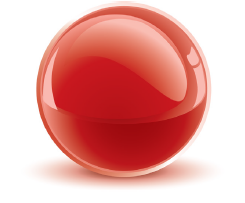Spheres
This problem solving activity has a number focus.

What is the radius of the sphere?
(For a sphere of radius r, its surface area is 4πr2 and its volume is 4/3π r3.)
- Use powers.
- Identify square and cube roots (with or without a calculator).
- Devise and use problem solving strategies to explore situations mathematically (be systematic, draw a diagram, use smaller cases).
In this problem students make estimations involving powers. At the outset, students should be encouraged to guess and check the size of the radius before working on it more closely. Having a calculator available will be an advantage.
Note that deriving the volume of a sphere, and working with a calculation to find the surface area of a sphere (by calculus) are not part of work at this level.
The Problem
The surface area and volume of a certain sphere are both 4-digit numbers times π. What is the radius of the sphere?
(For a sphere of radius r, its surface area is 4πr2 and its volume is 4/3πr3.)
Teaching Sequence
- State the problem. Ask:
What is the surface area of a sphere with radius 3?
What is the problem asking? - After some discussion, have the class work on the problem in groups. Ensure your students understand what is meant by the terms radius, power, and cube and square root.
- As they work, support with guiding questions as needed. Encourage students to work on the extension when they are ready.
- As solutions emerge, have groups that have used different approaches to the problem share these.
- Allow time for students to write up their solutions.
Extension
Repeat the problem for 2-digit, 3-digits and 5-digits. Then generalise and write a theorem covering all possibilities.
Solution
Method 1: Estimate a few values of r2 and r3 and see how big r has to be in order for it to produce the required 4-digit numbers. You should find that you can narrow the range down to bigger than or equal to16 using r2 and less than or equal to 19 using r3. There are only a few values that then need to be checked. 18 is the only value that works.
Method 2: Start on the surface area first. We know that 4r2 is a 4-digit number. That puts some restrictions on r . Get some idea of what these restrictions are. This can be done using the formal notation of inequalities but students might have their own way to do this. It should be logically correct.
9999 ≥ 4r2 ≥ 1000. Dividing both inequalities by 4 we get 2499 ≥ r2 ≥ 250. (Note that r is a whole number so we can take the biggest number less than 9999/4 in the left inequality.) Taking square roots all round we get 49 ≥ r ≥ 16 (again we can round up or down to whole numbers).
There are a lot of numbers between 16 and 49. Use a calculator as needed. What can the other information give us?
We also know that 9999 ≥ 4/3r3 ≥ 1000. This becomes 2499 ≥ 1/3r3 ≥ 250 or 7497 ≥ r3 ≥ 750. Taking cube roots gives 19 ≥ r ≥ 9.
Using the two inequalities we see that 19 ≥ r ≥ 16 and now we only have to test a few values of r. We know that 4/3 r3 is a 4-digit number. That means that 4r3 is 3 times a 4-digit number. Since 3 times a 4-digit number is divisible by 3, then so must 4r3 be. Hence 3 must be a factor of r3 and hence r. This only leaves us with r = 18. Check that this works.
Solution to the Extension
It might be possible to do the 2-digit case without using a calculator. Using either Method 1 or Method 2 we get r = 3 as the only answer.
In the 3-digit case we find that both 6 and 9 will work.
There are no answers for 5-digits. This is because to get 4r2 to be bigger than 10000 requires r to be bigger than 50 while for 4/3 r3 to be smaller than 99999 requires r to be smaller than 42. There are no numbers in that range.
From 5-digits on, the smallest value for r from 4r2 considerations is such that r/3 is bigger than 10. So 4/3 r3 is always at least 10 times 4r2. Hence they can’t both have the same number of digits.
Theorem: Let 4r2 and 4/3 r3 have the same number of digits. Then r = 6, 9 or 18.
Can you prove the case where they only have one digit?